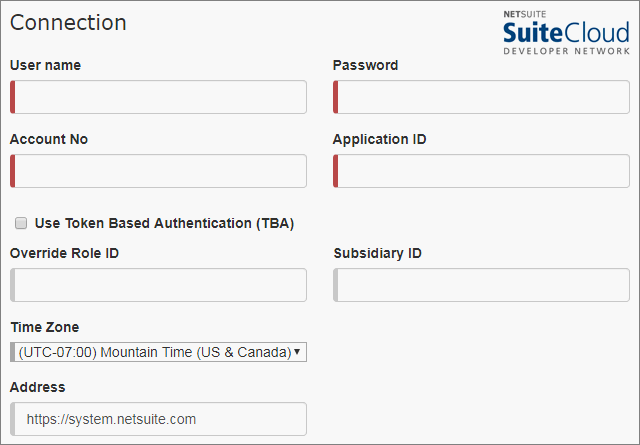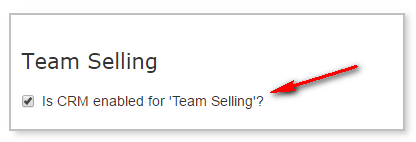The NetSuite connection supports user credentials and token-based authentication. You can switch from one to the other by selecting or clearing a check box.
To create and edit a NetSuite CRM connection in Riva Cloud:
- Create a NetSuite connection.
- Configure Team Selling.
- Select the contact type filters.
- Save the connection.
Step 1: Create a NetSuite Connection
-
Log in to https://www.rivacloud.com.
-
On the Get Started page, select Configure your CRM.
-
On the Select a supported CRM page, select NetSuite.
Result: The NetSuite Connection page appears. By default, it includes a user credentials field that is named Application ID.

-
If you want to use token-based authentication, select Use Token-Based Authentication (TBA).
Result: Between the check box and the fields below it, four token-based authentication fields appear.

-
Obtain the following information from your NetSuite administrator and enter it:
For any authentication type:
-
User Name: The user name of the Riva connection account.
-
Password: The password of the Riva connection account.
-
Account No: Provide the NetSuite Account ID. To find the Account ID, log in to NetSuite as an administrator, and select Setup > Integration > Web Services Preferences > Account ID.
-
Override Role ID: This is an ID number assigned to a role configured as the Web Services Default Role for the NetSuite account being used for this Riva Cloud connection. By default, if a user is assigned to only one role, NetSuite enables that role as the default Web Services role. This text box can normally be left blank. If the NetSuite account is assigned more than one role, the NetSuite administrator must define one of the roles as the default Web Services role. Contact your NetSuite administrator to obtain the number assigned to your default web services role and provide that value in this text box. For more information, see Prepare a Riva connection user for NetSuite.
-
Subsidiary ID: Applies to NetSuite OneWorld subscriptions ONLY. Leave blank unless this applies. In NetSuite OneWorld, companies can manage multiple subsidiaries, and the subsidiary field might be defined as mandatory when creating new contacts and/or customers. In this case, when Riva creates a contact or customer record in NetSuite, a default subsidiary value is required. The value for the Default Subsidiary field is the internal ID of the desired subsidiary. To find the required subsidiary, log in to NetSuite, and select Setup > Company Subsidiaries to see the list of subsidiaries.
-
Time Zone: On the drop-down list, select the timezone.
-
Address: The website URL to log in to your NetSuite CRM website console, for example https://system.netsuite.com
User Credentials:
Token-based authentication: The following values are generated in NetSuite when creating an application for token-based authentication For more information, see Token-based authentication setup tasks.
- Consumer Key.
- Consumer Secret.
- Token Id.
- Token Secret.
Step 2: Configure Team Selling
If Team Selling is enabled in NetSuite, Riva must also be configured to support this feature.
To enable Riva support of team selling:
Step 3: Select the Content Type Filters
By default, Riva is configured to sync contacts to customers (both individual and company), vendors, and partners.
-
Select the check boxes of the contact types that you want to synchronize, and clear the check boxes of the contact types that you do not want to synchronize.
For more information, see Contact type filtering options.
.png)
Step 4: Save the Connection
-
Select Save.
Result: The Riva Cloud service attempts to connect to your CRM account with the credentials and connection information that you have provided.
-
Do one of the following:
- If the connection setup is successful, select OK. The CRM connection is added to your Riva Cloud account.
- If you experience issues, contact the Riva Success Team.



.png)
